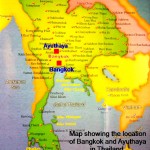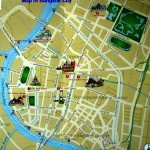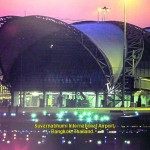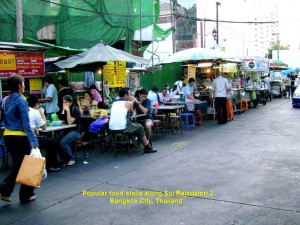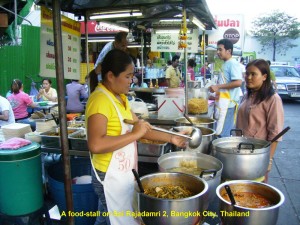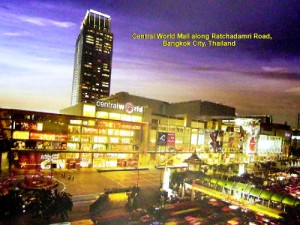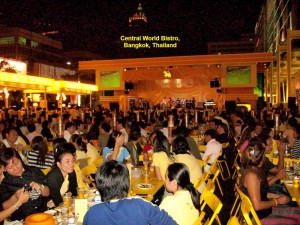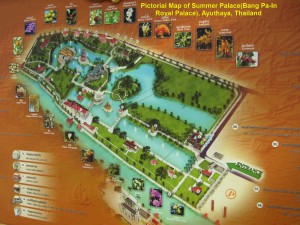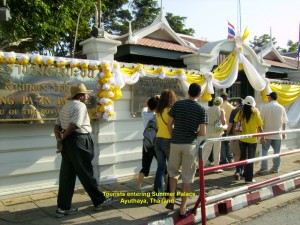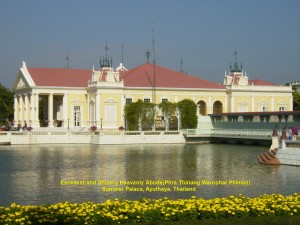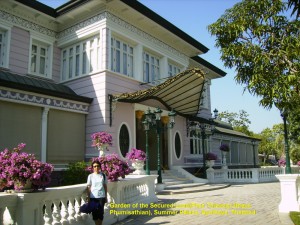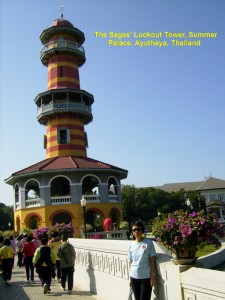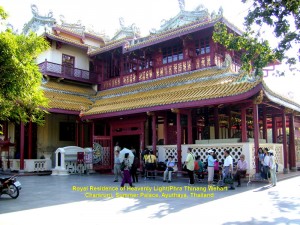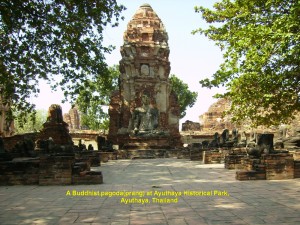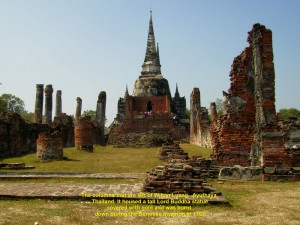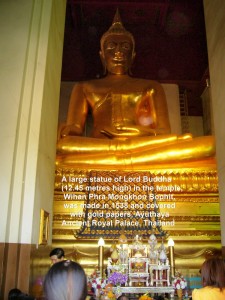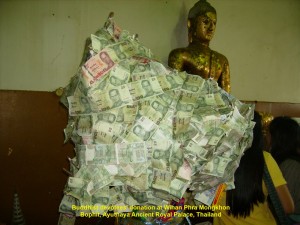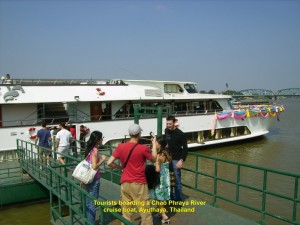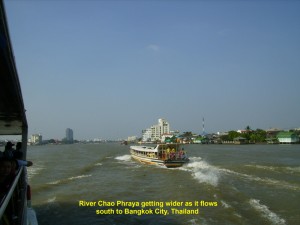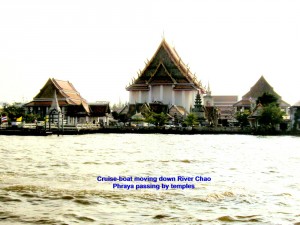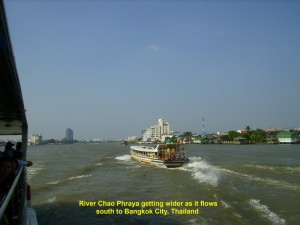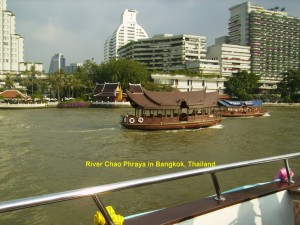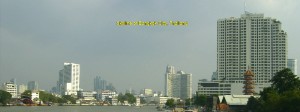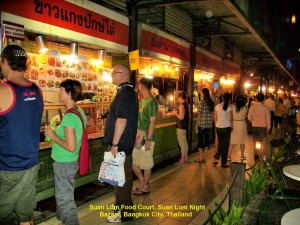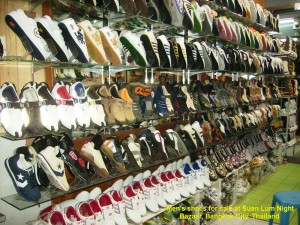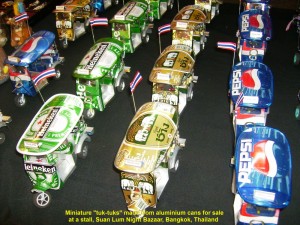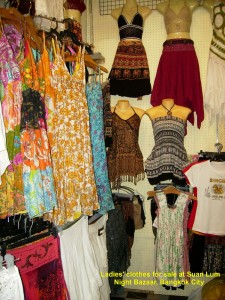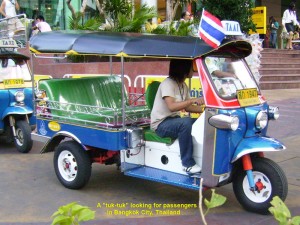Bangkok, Ayuthaya Travel (Part I)
Filed under: Ayuthaya Travel (Part I), Bangkok, Uncategorized
Bangkok began as a small village and later a trading centre. It developed rapidly when King Thaksin made it the new capital of Thailand in 1767. The old one, Ayutthaya, which is 80 km north of Bangkok, was captured by the Burmese soldiers in 1767.
People and Attractions
Bangkok has now become a fast growing city in Asia with a population of over 10 millions. Although it has become a financial and commercial hub of Thailand with modern, tall buildings, it still preserves the old ones which have historical, religious and cultural significance.
Known as the “City of Angels”, it attracts over 10 million tourists annually. It is well-known for Buddhist temples with unique architectural designs, food, shopping centres, night bazaars, roadside stalls, entertainment, historical and cultural sites.
Over 90% of its people of diverse races have a common religion, Buddhism and culture. There are about 400 Buddhist temples, 55 mosques, 10 churches and 2 Hindu temples in the city. As it has so many temples, it should also be known as the “City of Temples”. The Thais are helpful and friendly, and they live up to the country’s motto: “Land of Smiles”.
“Venice of the East”
Located on the east bank of River Chao Phraya in a low delta area with many rivers and canals (khlongs), Bangkok is known as “Venice of the East”. In olden days, canals or khlongs were built mainly for irrigating paddy fields and water transport. Many houses, shops and markets were built along those that were used as waterways. Some of them had floating markets. But nowadays many have been filled up to make way for roads.
Sinking Bangkok
Traffic jams and air-pollution are two major problems in the city now. Hopefully, the Thai government will find quick solutions to these problems, otherwise tourism will be affected badly. It is reported that the vibrant city is sinking and some parts of its land may be under water in 20 years’ time.
Bangkok and Ayuthaya, Writer’s Next Destinations
After an interesting trip to Chiang Mai, Chiang Rai and the Golden Triangle in Thailand in July 2006, my wife and I were off again to two more cities in Thailand in December 2007, i.e. Bangkok and Ayuthaya
On 4 December 2007, we left Kuala Lumpur Airport by an Air Asia airbus plane, A320 and, two hours later, we arrived safely at Bangkok’s new airport, Suvarnabhumi Airport, which was one year-old then. Built 28 km south-east of Bangkok, it is an airport which is comparable to other large international airports in the world. Its large, massive steel-roof looks like a row of curved and oval-shaped parachutes from a distance.
As a railway linking the airport and the Makkasan Station in the downtown was not ready yet, we took a taxi and in less than an hour to reach our budget hotel known as Bangkok City Inn in the downtown.
Below is the itinerary of our unforgettable Bangkok and Ayutthaya tour from 4 December 2007 till 7 December 2007.
1. Ratchadamri Nightlife and Central World
2. Ayutthaya : Bang Pa-In Palace
3. Ayutthaya : Wat Mahathat, Wat Phra Si Sanpet, Wihan Phra Mongkhon Bophit
4. Chao Phraya River Boat Cruise
5. Suan Lum Night Bazaar
6. The Grand Palace, The Emerald Buddha Temple, Temple of the Reclining Buddha, Wat Intrawihan
7. Anantasamakhon Throne Hall, King Rama V Monument, Democracy Monument, Victory Monument
8. Silom, Patpong and Chinatown
9. Thai Body Massage, Floating Market, Khlong Saen Saep and Phetburi Road
10. Bangkok City Inn, Vishnu Kurmavatara and Departure for Malaysia
Day 1 : Tuesday, 4 December 2007
Ratchadamri Road Nightlife
After checking in at Bangkok City Inn in Bangkok City we left the hotel in the evening and went to look for roadside food-stalls nearby to savour the cheap but nutritious Thai food for dinner. We found a row of them along Soi Rajadamri 2 which was nearby and tried their spicy, sweet and sour “tom yam”, fried rice, grilled chicken as well as fresh coconut drinks to cool our body system. Later, we found out that almost every street in the downtown had cheap roadside food-stalls.
Having finished our sumptuous meal we started our city sightseeing tour in Bangkok. The first place we visited was the busy Ratchadamri Road. The traffic was heavy on the road. As it was already evening, we saw lots of small stalls along both sides of the road selling all kinds of goods. They attracted a large number of both tourists and local people. The walkway was made narrow by the stalls and was so crowded that we had to be careful all the time not to bump into other people.
Central World
Then we walked to Bangkok’s largest shopping mall which is known as Central World. Located at the junction of Phloenchit Road and Ratchadamri Road, the modern multi-storey building houses many shops selling branded goods, such as watches, electrical and electronic products, jewellery, silverware, clothes, shoes, perfumes, cosmetics, etc. Besides, it has 21 cinema screens, 18 karaoke rooms and 28 bowling lanes. It is a place worth patronizing if you have lots of money.
Outside the Central World, we saw hundreds of people chill-out at two open-air bistros which had bands playing loud musics and local singers singing English and Thai songs. Adjacent to the bistros was an open space where there were many decorations including a tall Christmas tree lit with hundreds of small coloured bulbs that gave an atmosphere of Christmas festivity. This area was a popular place for families and young couples.
Day 2 : Wednesday, 5 December 2007
Travel to Ayutthaya
On the morning of 5 December 2007, we joined a group of tourists from different parts of the world for a tour in the ancient Ayutthaya to learn about its interesting past history, heritage and culture. At about 8.30 a.m. we departed Bangkok by a coach and headed north to the city.
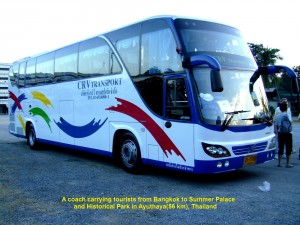
A coach bringing visitors from Bangkok City to the Summer Palace and Ancient Royal Palace in Ayuthaya, Thailand
Ayutthaya
Ayutthaya, located 86 km north of Bangkok, was founded in 1350. Since then it had been the capital of the Siamese Kingdom for 417 years before it was beseiged by the Burmese in 1767.
After the Burmese attack many buildings especially the temples were left in ruins and not much work has been done to restore them.
Ayutthaya has been declared as a World Heritage Ancient City as the ruined sites are a testament to its rich history and culture in its heyday.
Arrival at Summer Palace(Pang Pa-In Palace)
After travelling for about an hour we arrived at a famous ancient royal palace known as Bang Pa-In Palace or Royal Summer Palace which is 30 km south of Ayutthaya.
Before entering the palace a large portrait of the present Thai king greeted us. When we were inside the palace complex we were amazed to see a beautiful landscape of large manicured garden, neat rows of trees and flowers, lakes and mansions of European and Asian architectural styles.
Summer Palace (Pang Pa-In Palace)
In 1632 King Prasat Thong (1629-1659) was the first Thai king to build a palace as his residence there. Later, it was abandoned until King Mongkut or King Rama IV (1851-1868) restored it and made it as his residence. Subsequently, more mansions were built at the site by other kings. Many existing buildings were constructed during the reign of King Chulalongkorn or King Rama V (1868-1919) who loved European architectural styles.
The present king, King Bhumibol Adulyadej or King Rama IX, who lives at Chitralada Palace in Bangkok, occasionally, lives there and holds receptions and banquets.
After studying a pictorial map showing the locations of the mansions we toured the palace. Our Thai tour guide, Chamrong, who preferred to be called “James Bond” led us to the important mansions and patiently told us their histories. We toured the palace complex for an hour and found some buildings fascinating and worth mentioning below.
There are two parts of the Summer Palace: the outer and the inner.
1. The buildings in the outer part of the palace include:
a. Golden Palace of the God King Shrine (Ho Hem Monthian Thewarat)
Standing under a large old Bodhi tree is a small stone structure in the form of a Khmer-styled shrine. It was built by King Rama V in 1880 and dedicated to King Prasat Thong.
b. Assembly Hall for Ronal Relatives (Saphakhan Rajaprayon)
A royal residence built in 1879 for King Rama V’s brothers
c. The Divine Seat of Personal Freedom (Phra Thinang Aisawan Thiphya-Art)
This beautiful, brightly-coloured Thai architectural styled pavilion with 4 porches and a spire roof was built in a pond by King Rama V in 1876. It houses a bronze statue of King Rama V in a Field Marshal uniform that was placed there by his son, King Rama VI.
d. Excellent and Shinning Heavenly Abode (Phra Thinang Warophat Phiman)
A royal residence built in a neo-classic architectural style by King Rama V in 1876 as his residence and throne hall. Oil paintings depicting important events in Thai history and scenes from Thai literature can be seen in the audience chambers and ante-rooms.
e. Statues and Tree Sculptures in Summer Palace Garden
In the Summer Palace Garden there are several statues of ancient Greek figures and tree sculptures in animal figures. There is a bridge with some white marble statues of Greek figures and some in the garden. Besides, trees have been shaped into animal figures, like elephants and rabbits.
2. The buildings in the inner part of the Palace include:
a. Garden of the Secured Land (Phra Thinang Uthaya Phumisathian)
This is a large royal residence built at the expressed wishes of the present queen, Queen Sirikit. In 2006 Queen Elizabeth II of England was invited to stay there by the Thai king. She went to Thailand to celebrate his 60th. anniversary reign. This mansion replaces the wooden one which was accidentally burnt down during repair in 1938
b. The Sages Lookout Tower (Ho Withun Thasana)
This is a tall observatory tower built by King Rama V in 1881 for viewing the scenery of the countryside.
c. Royal Residence of Heavenly Light (Phra Thinang Wehart Chamrun)
It is a large two-storey Chinese-styled mansion given by a group of local Chinese businessmen as a gift to King Rama V in 1889
A Russian prince who visited the mansion in 1889 aptly described the striking red and yellow building as follows:
“It is really a palace of romance, with ornamented tiled floors, massive ebony furniture, gold, silver, and porcelain freely used for decorative purposes, and delicate fretwork on the columns and on the windows.”
There is a Chinese-styled throne on the ground floor. Besides, the building has an altar enshrining the plates with the names of King Rama IV, King Rama V and their respective queens. This mansion was a favourite residence of King Rama VI (1910-1925).
Journey to Ayuthaya
After a tour of the splendid Summer Palace we continued our journey to Ayuthaya which is well-known for ruined ancient temples
Ayutthaya was an important religious centre until the Burmese captured it in 1767. Many temples were burnt down by the enemies. Some large ruined ancient temples can still be seen in the city and are now a tourist attraction.

Chamrong, the tour-guide, telling the tourists about the ruined temples at the Ayuthaya Historical Park
On arrival at Ayuthaya, we visited some of the famous places of worship including the following:
a. Wat Mahathat
This ruined temple was built during the reign of King Boram Rachathirat in 1374 and completed during the reign of King Ramesuan (1388-1395) in 1390 to house the Lord Buddha’s relics. It was also used for the royal religious ceremonies as well as a place of worship by the locals and visitors.
During the Burmese attack in 1767 it was burnt down. Since then it was left in ruins. In the centre of the temple there was a large corn cob-shaped pagoda or prang (built in a Khmer-styled tower) that contained the Buddha’s relics. It collapsed in the reign of King Songtham (1610-1628). During the reign of King Prasat Thong (1630-1655), its restoration was completed and its height was greatly increased to 50 metres . Later the pagoda collapsed again due to an earthquake that happened during the reign of King Rama VI. The collapsed pagoda can still be seen at the temple.
Surrounding the pagoda are large and small stupas or chedis as well as large and small statues of Buddha. Many of these statues are either headless or torsoless. According to our tour Thai guide, Chamrong, looters had decapitated the statues and sold the heads to antique collectors. Besides, many relics of Buddha and other artifacts were stolen from the temple. Even the bricks were not spared. But visitors can still see some of the valuable temple artifacts recovered by archaeologists at the Chao Sam Phraya National Museum in Ayutthaya, e.g. Buddha statues, votive tablets, fish-shaped boxes and golden plaques in the shape of animals.
At the temple we were fascinated by a stone head of Lord Buddha image which appears out of the exposed roots of an old, large Bodhi tree. It is believed that the rest of its body is buried in the roots. A guard standing a few metres away from the head advised us not to let our heads be above that sacred head if we wanted to go near it to have a closer look.
Then we left that temple and went to another one nearby. It was Wat Phra Si Sanpet.
b. Wat Phra Si Sanpet
This temple was built in the large compound of a royal palace in 1448 without a monastery. It was used for royal ceremonies and religious rites. Besides, its compound was used for cremating the bodies of kings and royal family members.
Three large pagodas (stupas) were built to house the remains of the Siamese kings ( King Boroma-Tri-Loka-Nat, King Boroma-Rachathirat III and King
Ramathibodi II) and smaller ones the remains of the royal members.
Adjacent to this temple was a grand hall (Wihan Luang). It housed a tall golden Buddha statue (16 metres tall) known as Phra Si Sanpet. The statue covered with a layer of about 172 kg of gold was built by King Rama Thibodi II in 1500.
Unfortunately, in 1767 the Burmese came and burnt down the hall as well as the temple nearby. They also removed the gold from the large Buddha statue. A few tall pillars are the only remains of the grand hall that a visitor can see now. The large Buddha statue has been moved to the Phra Si Sanpet chedi in Wat Phra Cetuphon (Wat Po) in Bangkok.
c. Wihan Phra Mongkhon Bophit
This temple located in the old royal palace compound houses a large statue of Buddha known as Phra Mongkhon Bophit (12.45 metres high) and the latter is covered with gold leaves. This statue was made in 1538 on the order of King Chairachathirat.
Besides foreign tourists who thronged that ancient royal palace, lots of local people also visited the place as it was a public holiday in celebration of their king’s 80th. birthday.
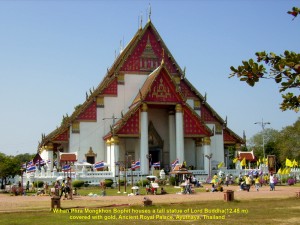
Wihan Phra Mongkhon Bophit houses a large golden statue of Lord Buddha at Ancient Royal Palace, Ayuthaya, Thailand
Elephant Show and Elephant Ride
Nearby, there was a mini elephant show and many people both foreign and locals alike were enjoying riding elephants. There were some who bought bananas and sugarcane to feed some hungry elephants in a large tent. The whole place looked like a carnival then.
Chao Phraya River Boat Cruise
After a tour of Ayutthaya’s two ancient ruined temples, viz. Wat Mahathat and Wat Phra Si Sanpet, and a grand hall, Wihan Phra Si Sanpet, we travelled south in our coach to Wat Chong-lom Pier in Nonthaburi. On arrival, we boarded a luxurious cruise boat of about 50 metres in length belonging to Grand Pearl Company Limited at Bangkok. It would take us down the large River Chao Phraya for a river-sighthseeing cruise.
Before the boat started, I was standing on the pier and busy snapping photos of the river sceneries. Then a boy appeared in front of me proudly showing off a large fish. I understood what he wanted me to do. So I snapped a photo of him with the fish and he grinned. Then his father holding a fishing rod came and teased him.
Soon the boat left the pier. As it was cruising slowly down the river, we enjoyed the sights and sounds of the river. We saw boats of different shapes and sizes past by, water hyacinth plants floating down the river, villages and towns on both sides of the river and anglers standing on river banks hoping for a big catch. Occasionally, large fish were seen jumping out of the water.
As we were getting nearer to Bangkok City, we saw lots of landmarks, historical and modern and went under a few old and modern bridges.
When we reached Bangkok we saw a spectacular sight of the city. It is a city of tall buildings of different heights, shapes and sizes. They are hotels, government buildings, shopping centres and condominiums. Many brightly-painted Siamese temples, a few churches and the famous Grand Palace can be seen too. Besides, the river is bustling with boats that ferry passengers across the river and carry tourists for a river-sightseeing tour.
After over two hours of the enjoyable river boat cruise we finally arrived at the River City Shopping Complex Pier and went back straight to our hotel to rest.
A Walk to Suan Lum Night Bazaar
In the evening, my wife and I decided to visit Suan Lum Night Bazaar. The bazaar is near the crossroads of Witthayu (Wireless) Road and Rama IV Road. Looking at the city map we thought it was not far from our hotel. So we decided to walk there. On the way, we came across a few groups of loyal hotel staff with burning candles standing in front of their hotels and waiting to celebrate their king’s 80th. birthday. After walking for half an hour we were surprised that we had not reached the bazaar yet. We realized the map we used was not drawn to scale. It took us another 15 minutes of walking before reaching our destination.
It was a sight of relief when we arrived at Suan Lum Night Bazaar. Feeling tired and famished, we made a beeline to the Thai food court, ordered some food and gobbled down all of it quickly. Then we took our time to browse a few hundreds of stalls.
Suan Lum Night Bazaar
This night bazaar which opens from 3 p.m. till midnight daily is a place where hundreds of stalls sell a wide variety of Thai products ranging from accessories, shoes and clothes to antiques, souvenirs, watches, arts and handicrafts. Besides, a traditional Thai puppet theatre, pet stalls, restaurants, pubs, food court, foot massage rooms and many more are found here. In other words, this night bazaar offers practically anything a visitor wants.
At a stall we were surprised to see aluminium cans made into objects for sale, like alarm clocks and “tuk-tuks”. Thais are truly creative and enterprising people.
After buying some articles at bargain prices and window shopping at the bazaar, we decided to go back to our hotel by a “tuk-tuk” (a three wheeled vehicle which runs on liquefied petroleum gas or LPG) instead of walking back.
Continue in Ayuthaya Travel (Part II)

